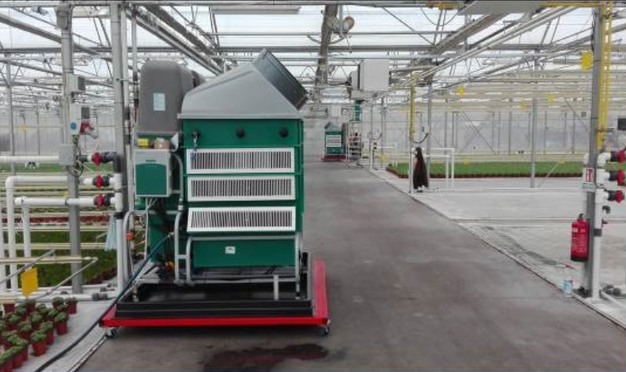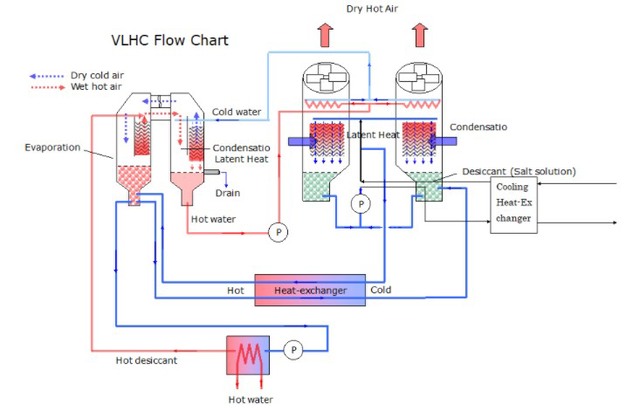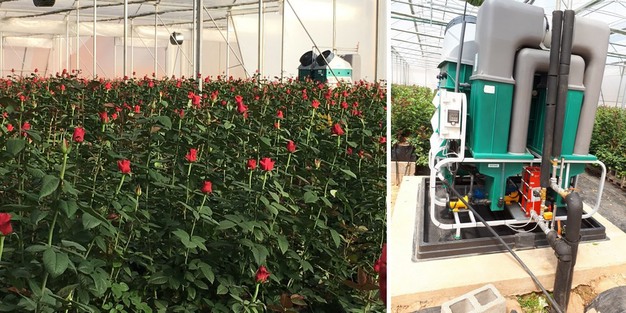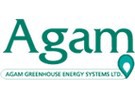The high relative humidity in the greenhouse was one of the main reasons for Hungarian fresh herb grower Akkos to invest in a dehumidifier. About four years ago, they installed the dehumidification systems of Agam Greenhouses and since then, plants are healthier and more stable than before. Special about this system is that it dries the air by using hygroscopic salt. It offers a solution to botrytis, saves energy and there are currently 825 of these machines in operation worldwide. It is mainly used for the cultivation of ornamentals, but over the last year the cannabis production spiked and soon they will finalize their 3-year trial in tomato crop.

The system at Akkos
From 100 to 70 percent humidity
At Akkos, they grow fresh herbs in a 3ha plastic greenhouse. For many years, they had to deal with a high humidity, around 100 percent and were eager to reduce this percentage. "As we grow in a plastic greenhouse, the level of relative humidity is high. As it affected the quality of our products, we were looking at a machine that would be able to decrease the level of humidity to 70 percent, which is ideal for us."
In their search for a dehumidifier, they came across the VLHC (Ventilated Latent Heat Converter) of Agam Greenhouses, an Israeli company. "We got in touch with Chaim Edelman of Agam Greenhouses and after hearing about the benefits regarding air purification, we decided to install 2 machines to trial it. After seeing the positive trial results, we decided to add 6 more. Now, we have 8 machines purifying the air of our 3ha plastic greenhouse."
At Akkos, they installed the machines about 4 years ago and he is still pleased with the results. "It brings down the RH to 70 percent. Only on the very rainy winter days it sometimes remains at 75 percent, but most of the time, it is at 70. And this is advantageous for our crop as we have less diseases and a more stable crop. In turn, we received more positive reactions from our customers."
And he adds that they, in the years they are using the machine, never had any issues. "They are still working very well, without any problems and care. We cannot imagine life and production without this machine"
Saving energy
For Akkos, the main reason for using the VLHC system is the fact that it is reducing the relative humidity in the greenhouse. However, besides dehumidification and constant filtration of airborne spores, they can provide heating as well as cooling. In turn, this makes the system more cost- and energy-effective. "From research done all over the world, the energy saving is 40 to 70 percent compared to a regular humidifier."

Click here for the enlarged version
How does it work?
Agam's dehumidification systems are hygroscopic systems. The technology enables air circulation with closed thermal screens and without roof ventilation, providing optimal and uniform humidity and temperature conditions, whilst dramatically reducing energy consumption and CO2 emission. But how does it work? Edelman explains the process. "Agam's systems use special hygroscopic brine that enables the conversion of humid air into dry air, reducing humidity-related diseases. Furthermore, as the air passes through the hygroscopic salt solution, airborne spores are reduced. Both conditions prevent the propagation of diseases, improve yield quality, significantly reduce crop loss and save money on fungicides and agrochemicals."

The system at Chinese rose grower Lynch, who has a farm in Yunnan China
Demand for cannabis cultivation spiked
Most of the systems are used by flower and ornamental plant growers. However, over the last two years, the demand from cannabis growers increased sharply. "The reason for this increase is mainly because of the fact that it decreases the occurrence of Botrytis combined with the fact that it saves energy", explains Edelman. Currently 825 systems are in operation all over the world. "We've have machines running in The Netherlands, Norway, Denmark, Australia, China, Japan, USA, Canada, Hungary, France, Belgium, Germany, Israel, Finland, Italy, Portugal, Spain, and Sweden."
Tomato trial ongoing
For three years now, they are trialing the system in a tomato greenhouse. Soon, they will have the final results, but according to Edelman, the results are looking surprisingly promising, so far.
 Agam Greenhouse Energy Systems Ltd.
Agam Greenhouse Energy Systems Ltd.Chaim Edelman
chaim@agam-energy.com
Tel. +972-8-9403050
Fax.+972-8-9403232
www.agam-greenhouses.com
www.agam-energy.com
